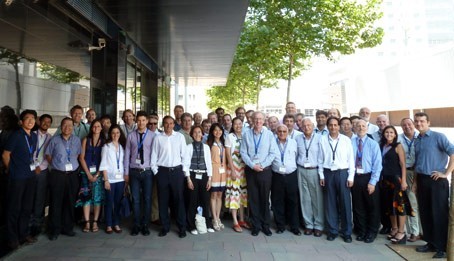F4E hosts ITER Neutronics meeting


The eighth annual ITER Neutronics meeting was hosted by F4E in Barcelona in July. The three-day event, which serves as a popular platform for discussion and dissemination of ITER nuclear-analysis issues, results and expertise, had the largest attendance of the series so far, with over 50 international delegates from Europe, China, India, Japan and the United States. The participants were mainly nuclear analysts and developers from the ITER International Organisation, ITER Domestic Agencies, academia and industry.
Neutronics is one of the key fields in the design of fusion technology. Thanks to their neutral nature, the 14 MeV neutrons generated in deuterium–tritium plasmas (as will be produced in ITER) deeply penetrate into surrounding components and release energy in the machine. Neutrons also generate tritium through reactions with lithium in a breeding blanket — the component that surrounds the plasma. In addition, neutron measurements provide important information about plasma parameters, such as shape, temperature and density, that are necessary to generate fusion conditions. On the other hand, neutrons also cause damage which has repercussions for the performance and lifetime of the tokamak components.
The ITER Neutronics meeting kicked off with a welcome address by Jean-Marc Filhol, F4E’s Head of ITER Department, during which he highlighted the importance of neutronics analyses and the value of this meeting series to foster communication and collaboration among experts. He noted that ITER neutronics issues, such as radiation effects in coils, and in components ensuring machine safety, have become a permanently monitored item in high-level ITER committee meetings.
The programme, prepared by F4E’s Technical Officer Raul Pampin, consisted of technical presentations and discussion sessions organised in several areas of expertise. Speakers highlighted challenges and progress within the field, particularly in the area of estimating parameters relevant to safety, i.e. radiation dose rates. Discussions focused on the development of crucial software and algorithms to simulate the unique and intricate conditions of the ITER machine, thereby enabling the production of reliable calculations of safety parameters in an efficient way. Furthermore, progress was made on the definition of much-needed general standards for neutronics computations. In conclusion, future needs and opportunities were identified for experiments to further validate the complex methods being developed.
The meeting was closed by Michael Loughlin, ITER’s Nuclear Coordination Officer, in a speech that summarised the most notable findings and conclusions, praised the efficient meeting organisation and highlighted very many positive outcomes of the event. His views were shared by the vast majority of attendees. He also announced that next year’s ITER Neutronics meeting will be hosted by ENEA and held in Frascati, Italy, during the month of May.
The meeting agenda, presentations and summary can be accessed here.